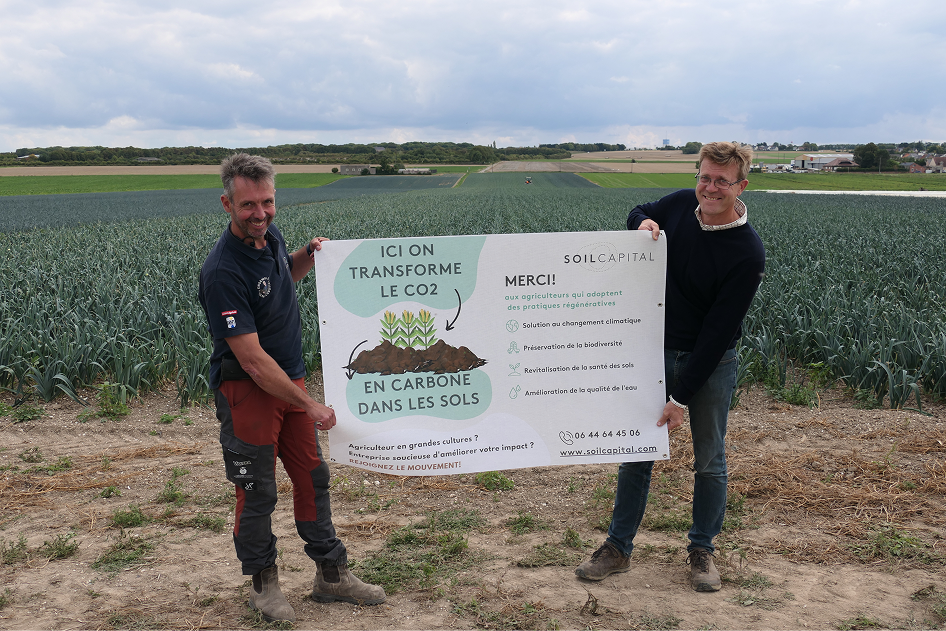Embracing Regenerative Agriculture, why is it crucial?
Regenerative agriculture is a sustainable farming approach that focuses on restoring and maintaining the health of ecosystems while producing food. Unlike conventional farming, which often depletes soil and harms the environment, regenerative agriculture enhances soil health, increases biodiversity, and sequesters carbon, helping to mitigate climate change. It also offers economic benefits for farmers by reducing costs, improving crop yields, and enhancing resilience to climate-related challenges. By supporting regenerative agriculture, companies can invest in more than just carbon credits, they contribute to long-term food security and environmental sustainability. Learn more about how carbon credits from regenerative agriculture can support your business here.
Globally, the agriculture sector accounts for 23% of greenhouse gas emissions, while food waste accounts for 8-10%. Being responsible for providing us with the majority of the food we eat, our soils are becoming tired. In recent years, regenerative agriculture has emerged as a transformative and sustainable approach to farming that aims to act both as “food saviour and climate hero”.
By aiming to restore and enhance the health of ecosystems, regenerative agriculture addresses critical issues such as soil degradation, water scarcity, and climate change, all while making farming more productive and profitable.
Mitigating climate change through carbon sequestration
Regenerative agriculture stands out as a powerful tool in the fight against climate change. The reduction of tillage, increased plant diversity, and the use of cover crops actively sequester carbon in the soil. By pulling carbon from the air and storing it in the soil, these activities help compensate for the CO2 emissions released by conventional agriculture. These carbon sequestration activities not only mitigate climate change but also improve soil structure and fertility. By helping the soil maintain its strength and health, fewer emissions are released from crop production and less topsoil is lost to erosion, thereby contributing to carbon avoidance activities as well. Therefore, regenerative agriculture projects can help avoid, reduce, and remove carbon emissions on a global scale.
.png?width=1200&length=1200&name=MicrosoftTeams-image%20(92).png)
.png?width=1200&length=1200&name=MicrosoftTeams-image%20(93).png)
It is important to mention that if farmers solely focus on sequestering carbon in their soils, there is the possibility of emitting more greenhouse gases in the process. For example, if a project intensifies its fertilizer usage to allow for more carbon storage, it can also increase the amount of nitrous oxide emitted in the process. Therefore, while mitigating climate change is an important part of regenerative agriculture, the soils should contribute to multiple ecosystem services and be beneficial to surrounding biodiversity.
The main pillars of regenerative agriculture includes:
-1.png?width=1595&height=655&name=MicrosoftTeams-image%20(85)-1.png)
Reducing Soil Disturbances: Contributing to Soil Regeneration and Fertility
At the core of regenerative agriculture is the commitment to restoring and preserving soil health. When farmers till their land, the objective is for water and air to enter the soil so that their seeds and roots can grow and for fertilizer to enter more effectively. However, in doing this long term the soil’s structure gets damaged and degrades over time. This causes the soil to lose water and nutrients, lessening the soil’s ability to retain water when there is a drought and leaving it vulnerable to microbial decomposition. The reduction of tillage, especially the transition to direct seeding, plays a crucial role in preserving the structure and life of the soil.
Farmers that engage in regenerative agriculture minimize these soil disturbances by reducing tillage or practicing no-till farming. These farmers use cover crops and plant seeds directly into the previous crop’s residue. This approach promotes the flourishing of essential soil organisms and helps prevent erosion, a common consequence of intensive ploughing.
Cover Crops: Enhancing Biodiversity and Ecosystem Health
Soil cover throughout the year further protects the soil against erosion, UV rays, and drought. This practice creates a barrier that prevents the formation of a compacted crust, enhances water retention, and competes with weeds, reducing the need for chemical interventions.
The diversity of cultivated species, especially when grown in association and through long rotations, contributes to improved soil fertility. This diversity helps in disease risk reduction, lowers weed and pest pressure, and promotes a more balanced and resilient ecosystem.
One of the standout features of regenerative agriculture is its focus on increasing biodiversity and fostering healthier ecosystems. Crop rotation, agroforestry intra-parcel development, and the incorporation of hedgerows create diverse habitats for beneficial insects, birds, and microorganisms. By practicing crop diversification, cover crops can improve soil health and protect the cash crop by limiting pest infestations, potentially reducing the need to fertilize. This holistic approach enhances ecosystem resilience, reduces the reliance on chemical inputs, and promotes a more balanced predator-prey relationship.
Reducing or Eliminating Pesticides/ Synthetic Fertilizers
When soils become dependent on synthetic fertilizers, it reduces the soil's capacity to spread nutrients without it. While pesticides and fertilizers are a common practice for farmers, the techniques of using cover crops and integrating no-till farming allows the soil’s natural ecosystem to grow and provide natural fertilizer. Practicing regenerative agriculture does not mean introducing a zero-input system, but rather activating the soil’s biology and removing the chemical inputs by introducing soil regeneration without removing soil’s critical components.
Associated Benefits of Regenerative Agriculture
The transition to regenerative agriculture brings about a myriad of benefits, both for the environment and the farming community. Improved water and air quality, better soil water retention, biodiversity conservation, and enhanced soil fertility are among the positive outcomes. Additionally, the reduction of fossil fuel consumption, the fight against soil erosion, and carbon avoidance/ sequestration contribute to a more sustainable and resilient agricultural system.
Farmers engaging in regenerative practices also stand to benefit economically. Local investments through carbon credits provide an additional income stream, incentivizing sustainable farming practices. Moreover, the nutritional quality of agricultural products is enhanced, contributing to a healthier diet for consumers.
The adoption of regenerative agriculture practices creates the following benefits:
- Improved Water and Air Quality: Reduced runoff and soil erosion lead to cleaner water sources, while healthier soils contribute to improved air quality.
- Better Soil Water Retention: Practices such as cover cropping and reduced tillage enhance the soil's ability to retain water, reducing the impact of drought.
- Biodiversity Conservation: Diverse cropping systems support a wide range of flora and fauna, promoting biodiversity conservation.
- Fertility Enhancement: The focus on soil health and diversity leads to improved fertility, reducing the need for synthetic fertilizers.
- Reduction of Fossil Fuel Consumption: Practices like reduced tillage and cover cropping can reduce the reliance on fossil fuels, making agriculture more sustainable.
- Fight Against Soil Erosion: By preserving soil structure and promoting ground cover, regenerative agriculture actively combats soil erosion.
- Carbon Sequestration in Soils: The storage of carbon in the soil mitigates climate change by offsetting carbon emissions from agricultural activities.
- Improvement of Nutritional Quality: Healthier soils produce crops with enhanced nutritional content, contributing to a more nutrient-rich diet.
- Local Investments via Carbon Credits: Participation in carbon credit programs provides farmers with additional income while supporting local sustainability initiatives.
- Path to a Healthier Diet: The emphasis on diverse, nutrient-rich crops aligns with a shift towards healthier and more sustainable dietary choices.
Regenerative agriculture presents a holistic and sustainable approach to address the pressing challenges faced by modern agriculture. By focusing on soil health, water management, biodiversity, and carbon avoidance/ sequestration, regenerative practices offer a path toward a more resilient, environmentally friendly, and economically viable food system. Embracing regenerative agriculture is not just a choice for farmers but a collective commitment to building a sustainable and thriving future for agriculture and our planet.
For more information on how regenerative agriculture generates avoidance and removal credits, read our blog.

Why invest in regenerative agriculture?
When asked about Nature-based Solutions (NbS) in the Voluntary Carbon Market (VCM), buyers would naturally mention flagship projects, such as, avoided deforestation or afforestation/ reforestation. There is now an emerging project type that contributors seek to support as they realize that agriculture is responsible for roughly 25% of global greenhouse gas (GHG) emissions - credits stemming from regenerative agriculture. In January 2025, Verra issued the first carbon credits using its VM0042 methodology for Improved Agricultural Land Management under its Verified Carbon Standard (VCS) Program.
Given the high cost of regenerative agriculture credits compared to other NbS projects and their relatively limited permanence, one might question why buyers should support them. We will see that those projects go much beyond carbon and can positively affect what daily impacts every human being on earth, i.e., food.
Environmental co-benefits
Conventional agriculture, which allowed most countries to achieve food security, came at a huge cost due to the depletion of soil nutrients and water tables, chemical fertilizers and pesticides polluting the soil while poisoning people and food, and loss in biodiversity.
Aside from avoiding and sequestering GHG emissions, shifting to more sustainable agriculture offers numerous environmental benefits:
- Water management: Regenerative agriculture practices can improve water retention in the soil, reduce the need for irrigation, and make farms more resilient to droughts.
- Soil health: Practices like cover cropping and agroecology not only sequester carbon but also improve the soil's overall health.
- Biodiversity: Agroforestry projects that incorporate trees on croplands provide habitat for species. Likewise, hedges are a fantastic biodiversity reservoir, and they even benefit from a dedicated methodology under the Label bas-carbone, a carbon standard for projects implemented on French territory.
Economic benefits
From a very pragmatic standpoint, regenerative agriculture can bring operational efficiency, along with, cost savings and more productivity:
- Practices such as no-till farming reduce the use of heavy machinery, leading to lower fuel costs.
- Using organic fertilizers can be cost-saving and decrease the reliance on imported fossil fuels, especially in the current tense geopolitical context. The price of chemical fertilizers reached a peak in the summer of 2022 when it almost quadrupled compared to the average in 2020. Indeed, their manufacturing relies on natural gas, and the war in Ukraine resulted in uncertainty and a supply shortage.
- Conventional agriculture is generally labor and carbon-intensive. While regenerative practices may require more planning and monitoring, especially in the first years of implementation, they can also prove to be less labor-intensive over time.
- Increased yield: By transitioning to regenerative farming practices, research shows that farmers stand to see an increase in crop yields and profits with a 15-25% return on investment.
Social co-benefits
If regenerative agriculture benefits both the environment and farmers' finances, is it truly additional? Wouldn't it have been adopted even without carbon finance? In short, should more sustainable agricultural practices qualify for carbon credits?
In most cases, the answer is yes, as several barriers still stand in the way of this transition:
- Price and income fluctuations: Farmers' revenues are subject to acute cyclical fluctuations due to weather conditions and global food markets, and it does not spare developed countries. Diversifying crops can allow them to increase resilience to climate change.
- Investment barrier: A study found that during the three-to-five-year transition period, farmers can expect up to nearly a USD $40 per acre profitability loss due to decreased crop yields and capital outlays for specialized equipment. Hence, farmers need to be financially rewarded as long as there is no return on investment.
- Change management: Project developers play a key role in accompanying farmers in their sustainable transition and assisting them. In temperate countries, there is only one annual crop, and farmers cannot take the chance of missing it due to a lack of appropriate practices.
Reinforced food security
Based on the 1996 World Food Summit, "Food security is defined as when all people, at all times, have physical and economic access to sufficient safe and nutritious food that meets their dietary needs and food preferences for an active and healthy life".
Regenerative agriculture supports this goal by preserving or restoring the environment while enhancing farmers' livelihoods. It is essential for long-term food security and for each country to maintain its sovereignty over its food systems.
For more information about carbon farming and how to support it, please contact our dedicated team of experts.
Why companies should invest in regenerative agriculture?
Regenerative agriculture offers numerous opportunities for companies looking to invest in sustainable practices. By focusing on soil health, biodiversity, and carbon sequestration, companies can contribute to environmental preservation while also reaping economic and social benefits. This farming approach reduces costs, enhances resilience to climate change, and helps meet growing consumer demand for eco-friendly products.
Additionally, companies can support carbon credit initiatives and contribute to food security, all while improving their brand reputation. How can your company leverage these opportunities? Explore more about carbon credits from regenerative farming by contacting our team.
Sources:
- Agriculture Duvivant
- Agoterra
- Climate Farmers
- FAO Reports
- IPCC
- Metabolic News
- Renature
- Syngenta Group
- Polytechnique
- Verra
- Institute of Sustainability Studies
- Label bas Carbone
- Euro News
- WBCSD
- Tresor Economy
- World Bank
Share this
You May Also Like
These Related Stories

Does Regenerative Agriculture Generate Carbon Avoidance or Removal Credits?

Agriculture and Climate Change: Problem-to-Solution Approach: Case Study with Soil Capital



